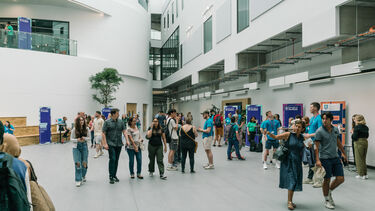I would genuinely recommend to anyone to consider studying EEE - it can allow you to understand the world we live in better, and give you the tools needed to make the world a better place.
Nathan
Electronic and Electrical Engineering PhD student and Departmental Ambassador
Whilst I was lucky to have had plenty of hands-on experience with electronics before university, for most that isn’t possible. So getting to help with the Department of Electronic and Electrical Engineering’s “Diodes R Us” event was a really awesome chance to help spark interest in engineering for the next generation. This event was run by Senior University Teacher Dr. Gavin Williams, who was assisted by technicians in the Electronics and Control Lab and student ambassadors such as myself. The event was part of a week-long timetable organised by the Faculty of Engineering at the University of Sheffield in collaboration with the Engineering Development Trust.
I completed a MEng in Electrical and Electronic Engineering (EEE) last year and continued on to do a PhD. The University of Sheffield has been a vital part of me getting the opportunity to explore my love for electronics at a more extensive practical level but also on a theoretical level. This way of teaching largely directed how we ran the event. We had plenty of hands-on time to set up circuits on the breadboards and check signals on the oscilloscope and spectrometer, but that was also supplemented by Gavin’s mini-lectures explaining bandgaps and how Pulse Width Modulation (PWM) worked.
The experiments we organised were characterising a diode with a Direct Current (DC) power supply. By applying voltages from -5v to 5v, we demonstrated how diodes have lots of conductivity in one direction and the opposite the other way around. We built on this new knowledge by constructing a half-wave rectifier on the breadboard next. By applying a sine waveform across the diode, the circuit clipped off the current flow during the periods of negative voltage. Then by adding a capacitor to smooth out the bumps, the students got to see a really simple version of how Alternating Current (AC) gets turned into DC. This process happens every day in your phone charger to keep it running! To charge your phone you need DC power, but your house only gets AC power.
For the next part of the session, we started playing around with some solar cells. These are really cool devices which generate a current when light shines on them. Students received a breakdown of the theory - the semiconductor in the cells absorb photons of light which then raise up an electron from the valence band to the conduction band. While that sounds quite complicated, it is a vital part of where we get electricity each day. In fact we generate approximately 5.5 GW of solar power each day against our usage of 30 GW across the country [1]. With that energy, we power homes and industry all over the UK. To show this, we hooked up the solar cells to a small DC fan. Then with a voltage regulator to stabilise the solar cell voltage to the motor, we managed to get the fans spinning.
We then finished up by messing around with the opposite to solar panels, the ubiquitous Light-Emitting Diode (LED). These work by taking in electricity and converting it to light. Using an arduino and a simple serial connection, we use PWM to vary voltage to RGB leds to combine them into making various shades of lights. Each subLED, Red, Green and Blue could each be set to any value between 0 and 255, representing a duty cycle of 0% all the way to 100%. By changing these the students managed to create purples and yellows all over the lab. We played around with working out how to make a white LED. While turning all the LEDs on to max did the trick, some enterprising folk tweaked the values to adjust how bright each subLED was to create a more balanced looking white light!
Finally we finished up by firing up MATLAB and playing around with a USB spectrometer to measure the wavelengths of the LEDs. From that we could calculate the energy of the photons and properly characterise them.
The event as a whole offered a great introduction to some of the ways that electronics fit into our modern-day life. These ways are so pervasive that they affect everything we do, yet they aren’t incomprehensible. From the components in our phone which are nanometers in size, to electronics at a far larger scale, electronic and electrical engineering has completely changed our world. This is probably what attracts me so much to EEE as a subject - it offers a really tangible way to make an impact. I really enjoyed helping out at this session because I would genuinely recommend to anyone to consider studying EEE - it can allow you to understand the world we live in better, and give you the tools needed to make the world a better place.
[1] http://www.gridwatch.templar.co.uk/ Accessed 2022-07-28





